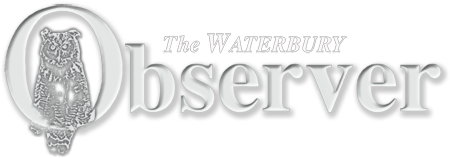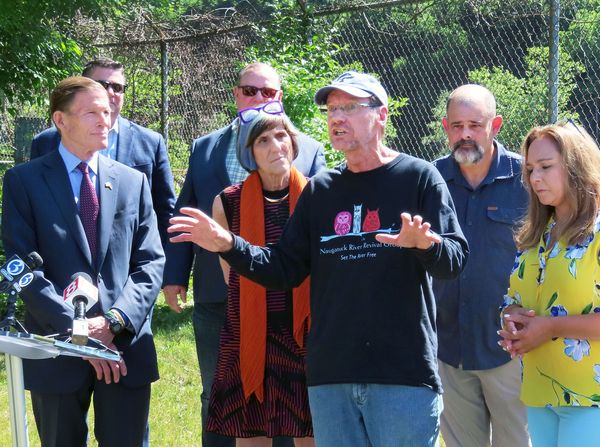(Subscribe to The Brass File to get it e-mailed free to your in-box by clicking on the link at the bottom of this page. After subscribing check your Spam folder the first few times as sometimes the bots think we’re trying to spam you.)
Story and Photographs By John Murray
After two decades of plucking shopping carts, tires, steel girders and plastic from the Naugatuck River, Kevin Zak, like a red-tailed hawk after its prey, has his eyes set on his ultimate prize; getting rid of the Kinneytown Dam in Seymour, or building effective fish passage around the aging structure.
“The Kinneytown Dam is a crime,” Zak said. “It is killing tens of thousands of migratory fish trying to spawn in the Naugatuck River. The fish ladder there doesn’t work, the dam has generated no electricity in the past two years and it serves no purpose. It is a killing machine.”
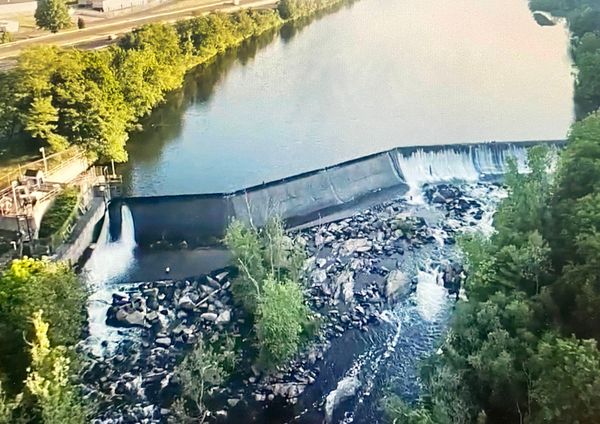
The Kinneytown Dam in Seymour, CT, has effectively transformed the Naugatuck River into a land-locked lake from Seymour to Winsted, and blocked fish passage to headwaters. |
Zak was speaking on the western edge of the Kinneytown Dam after the conclusion of a high-powered press conference that he had inspired on June 6th with years of door knocking and impassioned e-mails. In attendance was U.S. Congresswoman Rosa DeLauro, the chairwoman of the Appropriations Committee, U.S. Senator Richard Blumenthal, a staunch advocate of the environment and Long Island Sound (which water from the Naugatuck River eventually flows into), and Waterbury Mayor Neil O’Leary, who has fully embraced Zak’s vision of the river.
“No single person has done more to help the Naugatuck River than Kevin Zak,” O’Leary said. “He is down here day and night videotaping fish trapped at the bottom of the dam. He opened our eyes to what is happening here.”
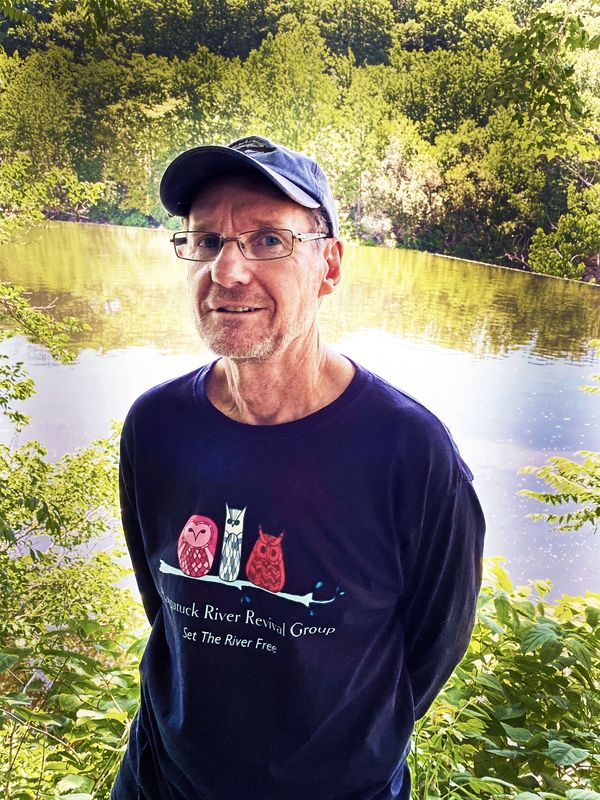
Kevin Zak of the Naugatuck River Revival Group. |
The situation is this; the Kinneytown Dam is owned by the Hydroland Omega Corporation located on Bainbridge Island in Washington, and they have failed to live up to Federal Regulatory Commission requirements. And in the past two years they have ignored mandatory upgrades with no consequence.
U.S. Senator Richard Blumenthal said, “All this dam does now is prevent fish from getting up the river. It’s offline and it is not operating. Hydroland’s license should be revoked.”
The goal of the press conference was to apply public pressure to the Federal Energy Regulatory Commission (FERC) to immediately hold Hydroland accountable.
“Hydroland has ignored what FERC asked them to do,” Mayor O’Leary said. “There needs to be more pressure exerted on Hydroland and more punitive action.”
As is often the case in dealing with local, state and federal governments, it’s unclear who the powerbroker in the situation is. FERC monitors the dam, the Federal Fish and Wildlife Services (FWS) is focused on the fish runs, and the Connecticut Department of Energy and the Environment (DEEP) is involved in monitoring the fish ladder at the Kinneytown Dam, which by all accounts is a colossal failure.
Zak and his wife, Sondra, created a non-profit organization, the Naugatuck River Revival Group, and they hired a Maine-based environmental lawyer, Ron Kreisman, who had experience with dam removals and fish passages. Kreisman is helping the Zaks navigate through bureaucracy.
“There is only one regulatory agency involved in allowing Hydroland to maintain an operation at Kinneytown,” Zak said. “This slipped thru the cracks for the past 20 years without intervention.”
With political and public pressure, Zak hopes that the dominoes will begin to fall in favor of the Naugatuck River running wild and free again.
“FERC has made it clear that they are looking for guidance from the federal Fish and Wildlife Services (FWS) and Connecticut DEEP for their next steps,” Zak said. “Even though FWS is technically the lead agency, FWS is looking to DEEP to lead the way.”
It’s a labyrinth of bureaucracy and anacronyms that is exceeding difficult to navigate, but Kevin Zak is neither intimidated nor discouraged.
“We cannot afford to wait another 20 years for another opportunity to end this senseless killing of migratory fish from their spawning grounds,” Zak said. “This is the key to the river’s restoration.”
The dam is not generating electricity and the fish passage doesn’t work. “From the beginning, the fish ladder never passed more than a few fish,” said Rick Dunne, the Executive Director of the Naugatuck Valley Council of Governments. “Things are starting to happen now: Senator Blumenthal raised the issue last year and drew attention to it. Fish and Wildlife got on top of the problem. Now Congresswoman DeLauro has been able to direct her attention to the matter and we see a great deal of activity at the federal level.”
Awareness of a problem, and then acknowledgement of it, almost always comes before a solution. Zak has been the driving force of identifying the issue, and community leaders and elected officials have acknowledged his findings. There is energy now in what has been a mostly a one-man campaign for the past 12 years.
Securing Neil O’Leary’s support was instrumental in Zak building his coalition.
When asked why a big city mayor would be so concerned about the Naugatuck River, O’Leary swatted the question like a Yankee slugger crushing a baseball over the right field fence.
“Economics,” O’Leary said emphatically. “A clean and wild Naugatuck River will have an enormous impact on the City of Waterbury and its residents for hundreds of years.”
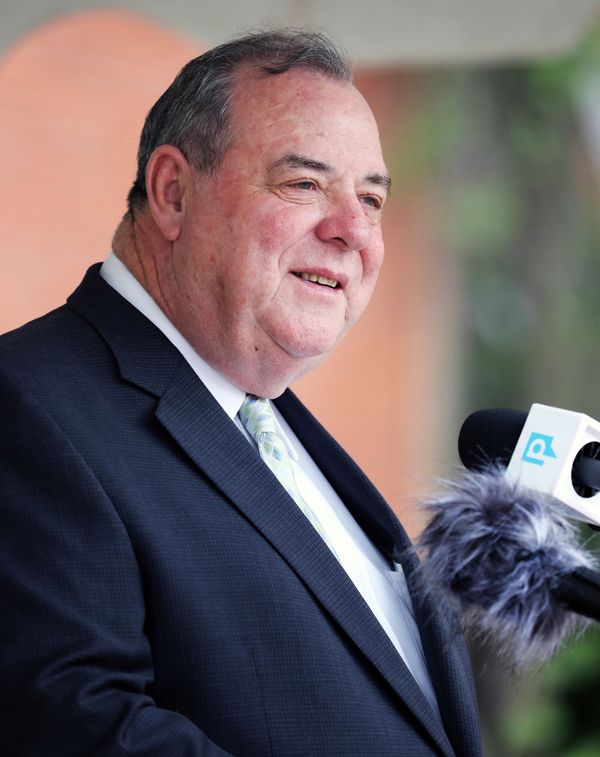
Waterbury Mayor Neil O’Leary has embraced the fight for a wild and free Naugatuck River. |
O’Leary said there would be a positive recreational impact as people would be in and around the river fishing, kayaking, canoeing and watching wildlife.
“There is also an environmental justice component to this as well,” O’Leary said. “We are building a greenway in the South End right now next to the Naugatuck River which brings recreational opportunities to vulnerable residents in Waterbury. I want to see children fishing in the river and right now the fishing in Waterbury is non-existent because the fish can’t get by the dam. It’s not right.”
One hot potato issue is who would be left with the responsibility of removing the dam and bearing the burden of costs and clean up. Sources have indicated that there is a plan, but they couldn’t share details at this moment.
“Waterbury Mayor Neil O’Leary and Naugatuck Mayor Pete Hess have made it very clear to state officials that they want to control the destiny of this river,” Zak said. “”We would be happy to talk to Hydroland and solve this problem together.”
U.S. Congresswoman Rosa DeLauro said it is time to hand over the dam. “Transfer the ownership of the dam under terms that are fair to the towns and the environmental communities,” DeLauro said. “Let’s begin the process of fully reopening this beautiful river.”
To say Kevin Zak is passionate about the Naugatuck River is as understated as saying a tsunami is a wave. Zak has invested thousands of hours cleaning the river, and filming and documenting the river as it heals itself from two centuries of industrial abuse.
When Zak was a child growing up in the Platts Mill neighborhood straddling the Waterbury/Naugatuck town line, he and his friends would play along the edge of the river, but few were reckless enough to actually go into a river stained with red and orange industrial dye, and poisoned by hundreds of thousands of gallons of chemical solvents dumped in the river by the brass and rubber industries. And bizarrely, the Naugatuck River actually caught on fire in 1929 when a spark ignited chemicals and oil on the surface of the river in Ansonia.
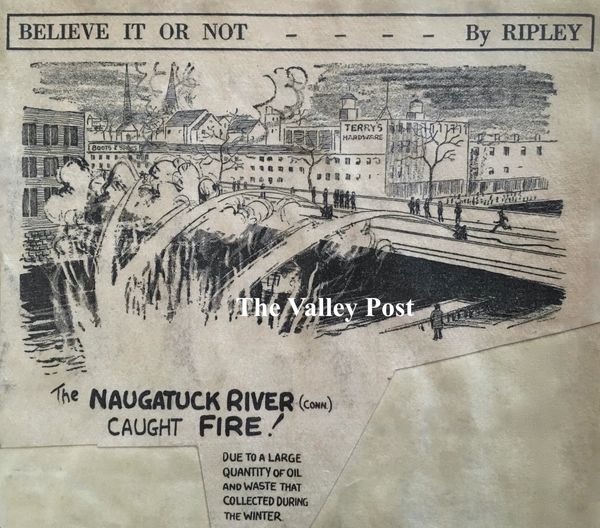 |
If the industrial pollution weren’t toxic enough, raw sewage flowed directly into the Naugatuck River until the 1940s, effectively making the 39-mile watershed a glorified toilet for industry and residents up and down the Naugatuck Valley.
Forty years of stricter environmental laws, sewage treatment plants and the removal of several dams in Waterbury in the 1990s have helped clean the river. Zak then picked up the cause to lead hundreds of river clean-ups, organize the first known canoe and kayak race on the river, and to compile thousands of hours of videotape documenting osprey, deer, beaver, green herons and bald eagles. It was Zak’s film project that led him to wonder where all the fish were. and his curiosity led him to the base of the Kinneytown Dam.
“I was stunned at what I found,” Zak said, “and I began videotaping the fish dying at the base of the Kinneytown Dam.”
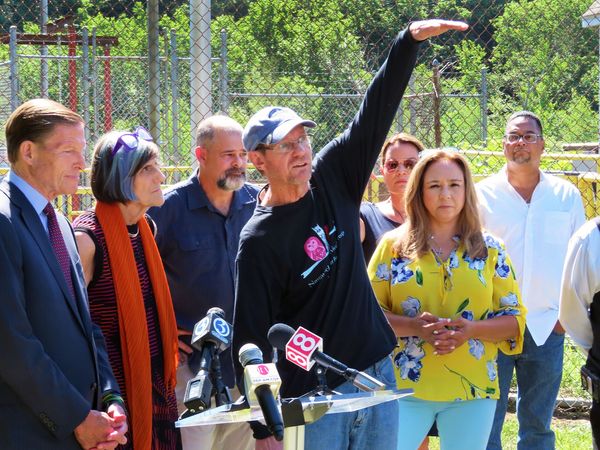
Kevin Zak illustrating the public good of a wild and free Naugatuck River. |
State Representative Geraldo Reyes Jr. represents the South End of Waterbury and has known Zak for more than a decade. Reyes was invited to the press conference and showed up to support Zak’s relentless and impassioned effort to almost single-handedly change the history of an entire watershed.
“Kevin Zak is the right man for this mission,” Reyes said. “He is a pit bull.”•
